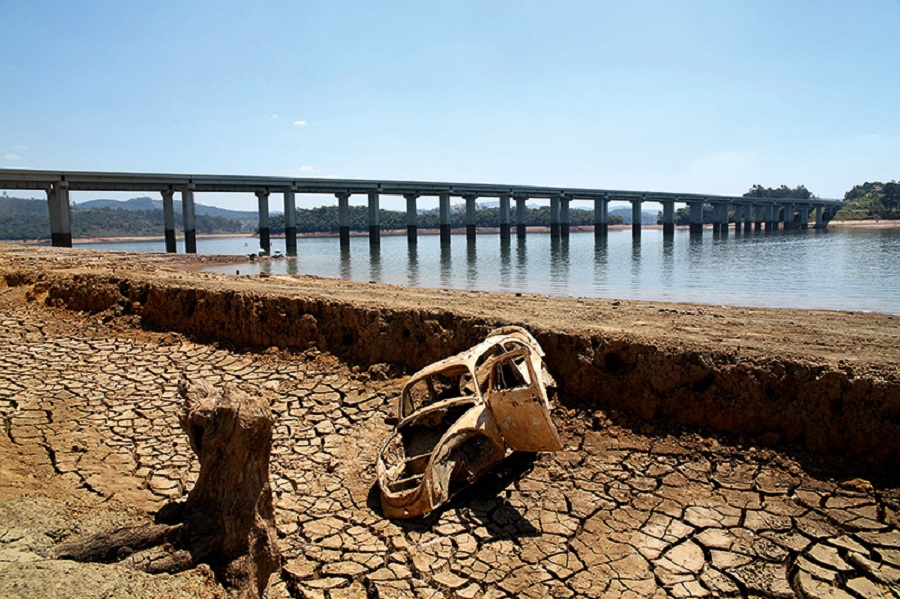RIO DE JANEIRO, BRAZIL – A week ago last Friday, the last trickle of treated and piped water dropped at the home of biologist Daniele Santana, 39 years old.
She had no hope that the taps would start running anytime soon, because the history is not good: the most recent wait had been 2 months. Moreover, she lives in one of Maricá’s neighborhoods, in the Metropolitan Region, served by the system whose output capacity CEDAE [the water company] announced on September 9 it would reduce to 45%.
The cause is the drought, with the consequent low level of the Ubatiba River which supplies populous areas in the municipality. This is only one of the pictures that the lack of rainfall – which dries up reservoirs, increases electricity prices, and leads to losses in the country – is spreading across the state of Rio.

In cities like Nova Friburgo and Petrópolis, residents are also experiencing problems to fill their water tanks and cisterns.
Government agencies and experts say that it is still not as bad as the water crisis Rio de Janeiro residents experienced in 2014 and 2015. But the scenario calls for attention, says environmental manager Marcelo Danilo Bogalhão, director of the Guandu Committee, which operates in the watershed supplying some 9 million people, including the population of the capital.
A large part of this basin’s water is transferred from the Paraíba do Sul River, where reservoir levels are among the lowest recorded for this time of year in the past two decades. According to a National Water and Basic Sanitation Agency (ANA) report, on Sunday the Paraibuna, Santa Branca, Jaguari and Funil reservoirs – along the Paraíba do Sul River – were operating, together, at a useful volume of 25.7% capacity.
On the same day in 2020, storage stood at 34.23%. In 2019, it reached 45.72%. As a comparison, the current level is the third worst for the date since 2004, higher only than the levels recorded in 2014 (16.32%) and 2015 (7.56%). Despite this scenario, CEDAE and the State Department of the Environment guarantee that there is no risk of a supply shortage. There are still no impacts in the Baixada Fluminense suburbs to the north of Rio de Janeiro, where the lack of water is chronic in some regions.
However, in late August the Rio de Janeiro Prosecutor’s Office and the Federal Prosecutor’s Office instructed both ANA and the Committee for the Integration of the Paraíba do Sul River Watershed (CEIVAP) to advise what measures are being or will be taken in case of a potential water shortage. In turn, Bogalhão notes that the reservoirs’ useful volume should ideally be close to 40%.
“The situation is better than in 2015. We are in a situation of caution. Public managers and the population need to be aware of conscious consumption. We need to limit the unnecessary use of water as much as possible. This is very important so that we can safely get through this period,” Bogalhão says, reiterating an appeal also made by the concessionaires that distribute water in the state.
REDUCTION IN IMUNANA
The situation is more critical in places where abstractions from rivers with no water accumulation reservoirs occur. Last month, CEDAE was forced to reduce water output in the Imunana-Laranjal system to 88%, due to the low flow of the spring (formed by the Macacu and Guapiaçu Rivers) where the water that supplies Niterói, São Gonçalo, Itaboraí, Ilha de Paquetá and the regions of Inoã and Itaipuaçu, in Maricá is collected.
The operation was normalized on August 29. But the company points out that “in case of a new drought, the output may have to be reduced again.”
In Maricá – one of the cities in which the population has increased the most in the state in recent years, reaching 167,600 people, according to IBGE estimates -, in the neighborhoods that rely on the Ubatiba River waters, including downtown, residents say that it is common for taps to run dry for days.
Biologist Daniele resorts to using tank cars to supply the water she needs for cooking and drinking. The family has an artesian well in their backyard.
“CEDAE always claims that there hasn’t been enough rain. But at a time like this, with barely any rain, how long will I be deprived of piped water?” she asks, living a few meters away from the Ubatiba River.

